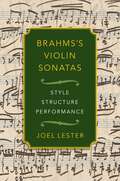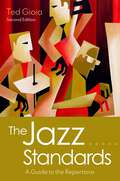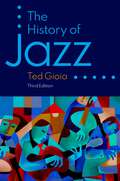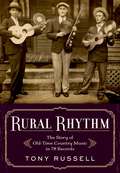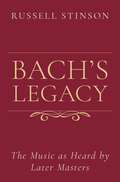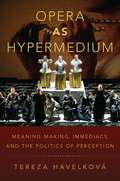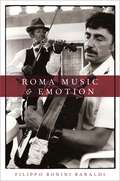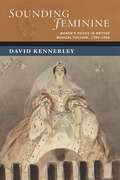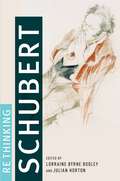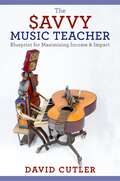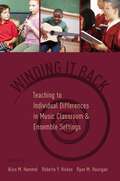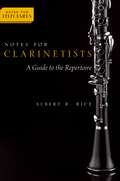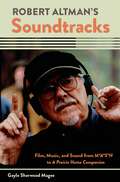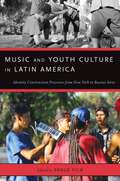- Table View
- List View
Brahms's Violin Sonatas: Style, Structure, Performance
by Joel LesterNotation in Johannes Brahms's sonata scores tells violinists and pianists far more than merely what pitches to play and how long to play them--if read carefully, these scores reveal an immense amount of expression, both of musical and human essences. Joel Lester's Brahms's Violin Sonatas magnifies key passages from these scores, revealing in clear and accessible language how the composer built his themes and musical narratives and how, ultimately, Brahms's music came to sound Brahmsian. Through close readings and annotated musical examples, Brahms's Violin Sonatas guides practitioners to read scores with care and to develop their own informed interpretation of the pieces, eschewing the notion of a single "correct" interpretation of the historical score. By exploring not only the sonatas' musical elements, but also their relationship to important events in the composer's life, Lester shows how subtle components can communicate the gestures, moods, personalities, and emotions that make Brahms's music so compelling. A companion volume to the author's award-winning 1999 study Bach's Works for Solo Violin: Style, Structure, and Performance (OUP), Brahms's Violin Sonatas is a clear and practical guide to understanding and performing Brahms's music in the present.
Brahms's Violin Sonatas: Style, Structure, Performance
by Joel LesterNotation in Johannes Brahms's sonata scores tells violinists and pianists far more than merely what pitches to play and how long to play them--if read carefully, these scores reveal an immense amount of expression, both of musical and human essences. Joel Lester's Brahms's Violin Sonatas magnifies key passages from these scores, revealing in clear and accessible language how the composer built his themes and musical narratives and how, ultimately, Brahms's music came to sound Brahmsian. Through close readings and annotated musical examples, Brahms's Violin Sonatas guides practitioners to read scores with care and to develop their own informed interpretation of the pieces, eschewing the notion of a single "correct" interpretation of the historical score. By exploring not only the sonatas' musical elements, but also their relationship to important events in the composer's life, Lester shows how subtle components can communicate the gestures, moods, personalities, and emotions that make Brahms's music so compelling. A companion volume to the author's award-winning 1999 study Bach's Works for Solo Violin: Style, Structure, and Performance (OUP), Brahms's Violin Sonatas is a clear and practical guide to understanding and performing Brahms's music in the present.
The Jazz Standards: A Guide to the Repertoire
by Ted GioiaAn updated new edition of Ted Gioia's acclaimed compendium of jazz standards, featuring 15 additional selections, hundreds of additional recommended tracks, and enhancements and additions on almost every page. Since the first edition of The Jazz Standards was published in 2012, author Ted Gioia has received almost non-stop feedback and suggestions from the passionate global community of jazz enthusiasts and performers requesting crucial additions and corrections to the book. In this second edition, Gioia expands the scope of the book to include more songs, and features new recordings by rising contemporary artists. The Jazz Standards is an essential comprehensive guide to some of the most important jazz compositions, telling the story of more than 250 key jazz songs and providing a listening guide to more than 2,000 recordings. The fan who wants to know more about a tune heard at the club or on the radio will find this book indispensable. Musicians who play these songs night after night will find it to be a handy guide, as it outlines the standards' history and significance and tells how they have been performed by different generations of jazz artists. Students learning about jazz standards will find it to be a go-to reference work for these cornerstones of the repertoire. This book is a unique resource, a browser's companion, and an invaluable introduction to the art form.
The Jazz Standards: A Guide to the Repertoire
by Ted GioiaAn updated new edition of Ted Gioia's acclaimed compendium of jazz standards, featuring 15 additional selections, hundreds of additional recommended tracks, and enhancements and additions on almost every page. Since the first edition of The Jazz Standards was published in 2012, author Ted Gioia has received almost non-stop feedback and suggestions from the passionate global community of jazz enthusiasts and performers requesting crucial additions and corrections to the book. In this second edition, Gioia expands the scope of the book to include more songs, and features new recordings by rising contemporary artists. The Jazz Standards is an essential comprehensive guide to some of the most important jazz compositions, telling the story of more than 250 key jazz songs and providing a listening guide to more than 2,000 recordings. The fan who wants to know more about a tune heard at the club or on the radio will find this book indispensable. Musicians who play these songs night after night will find it to be a handy guide, as it outlines the standards' history and significance and tells how they have been performed by different generations of jazz artists. Students learning about jazz standards will find it to be a go-to reference work for these cornerstones of the repertoire. This book is a unique resource, a browser's companion, and an invaluable introduction to the art form.
The History of Jazz
by Ted GioiaAn updated new edition of Ted Gioia's universally acclaimed history of jazz, with a wealth of new insight on this music's past, present, and future. Ted Gioia's The History of Jazz has been universally hailed as the most comprehensive and accessible history of the genre of all time. Acclaimed by jazz critics and fans alike, this magnificent work is now available in an up-to-date third edition that covers the latest developments in the jazz world and revisits virtually every aspect of the music. Gioia's story of jazz brilliantly portrays the most legendary jazz players, the breakthrough styles, and the scenes in which they evolved. From Louis Armstrong and Duke Ellington at the Cotton Club, Miles Davis's legendary 1955 performance at the Newport Jazz Festival, and Ornette Coleman's experiments with atonality to current innovators such as Kamasi Washington and Esperanza Spalding, Gioia takes readers on a sweeping journey through the history of jazz. As he traces the music through the swamp lands of the Mississippi Delta, the red light district of New Orleans, the rent parties of Harlem, the speakeasies of Chicago, and other key locales of jazz history, Gioia also makes the social contexts in which the music was born come alive. This new edition finally brings the often overlooked women who shaped the genre into the spotlight and traces the recent developments that have led to an upswing of jazz in contemporary mainstream culture. As it chronicles jazz from its beginnings and most iconic figures to its latest dialogues with popular music, the developments of the digital age, and new commercial successes, Gioia's History of Jazz reasserts its status as the most authoritative survey of this fascinating music.
The History of Jazz
by Ted GioiaAn updated new edition of Ted Gioia's universally acclaimed history of jazz, with a wealth of new insight on this music's past, present, and future. Ted Gioia's The History of Jazz has been universally hailed as the most comprehensive and accessible history of the genre of all time. Acclaimed by jazz critics and fans alike, this magnificent work is now available in an up-to-date third edition that covers the latest developments in the jazz world and revisits virtually every aspect of the music. Gioia's story of jazz brilliantly portrays the most legendary jazz players, the breakthrough styles, and the scenes in which they evolved. From Louis Armstrong and Duke Ellington at the Cotton Club, Miles Davis's legendary 1955 performance at the Newport Jazz Festival, and Ornette Coleman's experiments with atonality to current innovators such as Kamasi Washington and Esperanza Spalding, Gioia takes readers on a sweeping journey through the history of jazz. As he traces the music through the swamp lands of the Mississippi Delta, the red light district of New Orleans, the rent parties of Harlem, the speakeasies of Chicago, and other key locales of jazz history, Gioia also makes the social contexts in which the music was born come alive. This new edition finally brings the often overlooked women who shaped the genre into the spotlight and traces the recent developments that have led to an upswing of jazz in contemporary mainstream culture. As it chronicles jazz from its beginnings and most iconic figures to its latest dialogues with popular music, the developments of the digital age, and new commercial successes, Gioia's History of Jazz reasserts its status as the most authoritative survey of this fascinating music.
Rural Rhythm: The Story of Old-Time Country Music in 78 Records
by Tony RussellThere are many biographies and histories of early country music and its creators, but surprisingly little attention has been given to the actual songs at the heart of these narratives. In this groundbreaking book, music historian Tony Russell turns the spotlight on seventy-eight original 78rpm discs of songs and tunes from the 1920s and 1930s, uncovering the hidden stories of how they came to be recorded, the musicians who sang and played them, the record companies that marketed them, and the listeners who absorbed them. In these essays, based upon new research, contemporary newspaper accounts, and previously unpublished interviews, and copiously illustrated with rare images, readers will find songs about home and family, love and courtship, crime and punishment, farms and floods, chain gangs and chain stores, journeys and memories, and many other aspects of life in the period. Rural Rhythm not only charts the tempos and styles of rural and small-town music-making and the origins of present-day country music, but also traces the larger rhythms of life in the American South, Southwest, and Midwest. What emerges is a narrative that ingeniously blends the musical and social history of the era.
Rural Rhythm: The Story of Old-Time Country Music in 78 Records
by Tony RussellThere are many biographies and histories of early country music and its creators, but surprisingly little attention has been given to the actual songs at the heart of these narratives. In this groundbreaking book, music historian Tony Russell turns the spotlight on seventy-eight original 78rpm discs of songs and tunes from the 1920s and 1930s, uncovering the hidden stories of how they came to be recorded, the musicians who sang and played them, the record companies that marketed them, and the listeners who absorbed them. In these essays, based upon new research, contemporary newspaper accounts, and previously unpublished interviews, and copiously illustrated with rare images, readers will find songs about home and family, love and courtship, crime and punishment, farms and floods, chain gangs and chain stores, journeys and memories, and many other aspects of life in the period. Rural Rhythm not only charts the tempos and styles of rural and small-town music-making and the origins of present-day country music, but also traces the larger rhythms of life in the American South, Southwest, and Midwest. What emerges is a narrative that ingeniously blends the musical and social history of the era.
Bach's Legacy: The Music as Heard by Later Masters
by Russell StinsonJohann Sebastian Bach's legacy is undeniably one of the richest in the history of music, with a vast influence on posterity that has only grown since his rediscovery in the early nineteenth century. In this latest addition to his long list of Bach studies, renowned Bach scholar Russell Stinson examines how four of the greatest composers of the nineteenth and twentieth centuries - Felix Mendelssohn, Robert Schumann, Richard Wagner, and Edward Elgar - engaged with Bach's legacy, not only as composers per se, but also as performers, conductors, scholars, critics, and all-around musical ambassadors. Detailed analyses of both musical and epistolary sources shed light on how these later masters heard and received Bach's music within their musical circles, while colorful anecdotes about their Bach reception help humanize them, reconstructing the intimate social circumstances in which they performed and discussed Bach's music. Stinson focuses on Mendelssohn's and Schumann's reception of Bach's organ works, Schumann's encounter with the St. Matthew and St. John Passions, Wagner's musings on the Well-Tempered Clavier, and Elgar's (resoundingly negative) thoughts on Bach as a vocal composer. Engagingly written, copiously annotated, and thoroughly up to date, Bach's Legacy traces the historical afterlife of Bach's music and offers fascinating insights into how these later masters defined it for their audiences and beyond.
Bach's Legacy: The Music as Heard by Later Masters
by Russell StinsonJohann Sebastian Bach's legacy is undeniably one of the richest in the history of music, with a vast influence on posterity that has only grown since his rediscovery in the early nineteenth century. In this latest addition to his long list of Bach studies, renowned Bach scholar Russell Stinson examines how four of the greatest composers of the nineteenth and twentieth centuries - Felix Mendelssohn, Robert Schumann, Richard Wagner, and Edward Elgar - engaged with Bach's legacy, not only as composers per se, but also as performers, conductors, scholars, critics, and all-around musical ambassadors. Detailed analyses of both musical and epistolary sources shed light on how these later masters heard and received Bach's music within their musical circles, while colorful anecdotes about their Bach reception help humanize them, reconstructing the intimate social circumstances in which they performed and discussed Bach's music. Stinson focuses on Mendelssohn's and Schumann's reception of Bach's organ works, Schumann's encounter with the St. Matthew and St. John Passions, Wagner's musings on the Well-Tempered Clavier, and Elgar's (resoundingly negative) thoughts on Bach as a vocal composer. Engagingly written, copiously annotated, and thoroughly up to date, Bach's Legacy traces the historical afterlife of Bach's music and offers fascinating insights into how these later masters defined it for their audiences and beyond.
Opera as Hypermedium: Meaning-Making, Immediacy, and the Politics of Perception
by Tereza HavelkováDrawing on the concept of hypermediacy from media studies, this book situates opera within the larger context of contemporary media practices, and particularly those that play up the multiplicity, awareness and enjoyment of media. It is driven by the underlying question of what politics of representation and perception opera performs within this context. This entails approaching operas as audiovisual events (rather than works or texts) and paying attention to what they do by visual means, along with the operatic music and singing. The book concentrates on events that foreground their use of media and technology, drawing attention to opera's inherently hypermedial aspects. It works with the recognition that such events nevertheless engender powerful effects of immediacy, which are not contingent on illusionism or the seeming transparency of the medium. It analyzes how effects like presence, liveness and immersion are produced, contesting some critical claims attached to them. It also sheds light on how these effects, often perceived as visceral or material in nature, are related to the production of meaning in opera. The discussion pertains to contemporary pieces such as Louis Andriessen and Peter Greenaway's Rosa and Writing to Vermeer, as well as productions of the canonical repertory such as Wagner's Ring Cycle by Robert Lepage at the Met and La Fura dels Baus in Valencia.
Opera as Hypermedium: Meaning-Making, Immediacy, and the Politics of Perception
by Tereza HavelkováDrawing on the concept of hypermediacy from media studies, this book situates opera within the larger context of contemporary media practices, and particularly those that play up the multiplicity, awareness and enjoyment of media. It is driven by the underlying question of what politics of representation and perception opera performs within this context. This entails approaching operas as audiovisual events (rather than works or texts) and paying attention to what they do by visual means, along with the operatic music and singing. The book concentrates on events that foreground their use of media and technology, drawing attention to opera's inherently hypermedial aspects. It works with the recognition that such events nevertheless engender powerful effects of immediacy, which are not contingent on illusionism or the seeming transparency of the medium. It analyzes how effects like presence, liveness and immersion are produced, contesting some critical claims attached to them. It also sheds light on how these effects, often perceived as visceral or material in nature, are related to the production of meaning in opera. The discussion pertains to contemporary pieces such as Louis Andriessen and Peter Greenaway's Rosa and Writing to Vermeer, as well as productions of the canonical repertory such as Wagner's Ring Cycle by Robert Lepage at the Met and La Fura dels Baus in Valencia.
Roma Music and Emotion
by Filippo Bonini BaraldiIn Roma Music and Emotion, author Filippo Bonini Baraldi forges a much-needed theory of music, emotion, and empathy from an anthropological perspective, addressing the failure of the prevailing psychological theories on music and emotion to account for non-western musical cultures. Bonini Baraldi, having spent years among the Hungarian Roma of rural Transylvania, presents compelling ethnographic descriptions of their weddings, funerals, community celebrations, and intimate family gatherings. Based on extensive field research and informed by hypotheses drawn from the cognitive sciences, the anthropology of art, and aesthetics, Roma Music and Emotion analyzes why Roma musicians cry along with music and how they arouse specific feelings in their audiences. Translated by Margaret Rigaud, and with a Foreword by Steven Feld, Roma Music and Emotion makes an important ethnomusicological contribution to theoretical discussions of the relationship between music and emotion.
Roma Music and Emotion
by Filippo Bonini BaraldiIn Roma Music and Emotion, author Filippo Bonini Baraldi forges a much-needed theory of music, emotion, and empathy from an anthropological perspective, addressing the failure of the prevailing psychological theories on music and emotion to account for non-western musical cultures. Bonini Baraldi, having spent years among the Hungarian Roma of rural Transylvania, presents compelling ethnographic descriptions of their weddings, funerals, community celebrations, and intimate family gatherings. Based on extensive field research and informed by hypotheses drawn from the cognitive sciences, the anthropology of art, and aesthetics, Roma Music and Emotion analyzes why Roma musicians cry along with music and how they arouse specific feelings in their audiences. Translated by Margaret Rigaud, and with a Foreword by Steven Feld, Roma Music and Emotion makes an important ethnomusicological contribution to theoretical discussions of the relationship between music and emotion.
Sounding Feminine: Women's Voices in British Musical Culture, 1780-1850 (New Cultural History of Music)
by David KennerleyBetween 1780 and 1850, the growing prominence of female singers in Britain's professional and amateur spheres opened a fraught discourse about women's engagement with musical culture. Protestant evangelical gender ideology framed the powerful, well-trained, and expressive female voice as a sign of inner moral corruption, while more restrained and delicate vocal styles were seen as indicative of the performer's virtuous femininity. Yet far from everyone was of this persuasion, and those from alternative class and religious milieux responded in more affirmative ways to the sound of professional female voices. The meanings listeners ascribed to women's voices reflect crucial developments in the musical world of the period, such as the popularity of particular genres with audiences of certain social backgrounds, and the reasons underpinning the development of prevalent types of nineteenth-century professional female vocality. Sounding Feminine traces the development of attitudes towards the female voice that have decisively shaped modern British society and culture. Arguing for the importance of the aural dimension of the past, author David Kennerley draws from a variety of fields-including sound studies, sensory histories, and gender theory-to examine how audiences heard different kinds of femininities in the voices of British female singers. Sounding Feminine explores the intense divisions over the "correct" use of the female voice, and the intricate links between gender, nationality, class, and religion in ascribing status, purpose, and morality to female singing. Through this lens, Kennerley also explores the formation of British middle-class identities and the cultural impact of the evangelical revival-deepening our understanding of this period of transformational change in British culture.
Sounding Feminine: Women's Voices in British Musical Culture, 1780-1850 (New Cultural History of Music)
by David KennerleyBetween 1780 and 1850, the growing prominence of female singers in Britain's professional and amateur spheres opened a fraught discourse about women's engagement with musical culture. Protestant evangelical gender ideology framed the powerful, well-trained, and expressive female voice as a sign of inner moral corruption, while more restrained and delicate vocal styles were seen as indicative of the performer's virtuous femininity. Yet far from everyone was of this persuasion, and those from alternative class and religious milieux responded in more affirmative ways to the sound of professional female voices. The meanings listeners ascribed to women's voices reflect crucial developments in the musical world of the period, such as the popularity of particular genres with audiences of certain social backgrounds, and the reasons underpinning the development of prevalent types of nineteenth-century professional female vocality. Sounding Feminine traces the development of attitudes towards the female voice that have decisively shaped modern British society and culture. Arguing for the importance of the aural dimension of the past, author David Kennerley draws from a variety of fields-including sound studies, sensory histories, and gender theory-to examine how audiences heard different kinds of femininities in the voices of British female singers. Sounding Feminine explores the intense divisions over the "correct" use of the female voice, and the intricate links between gender, nationality, class, and religion in ascribing status, purpose, and morality to female singing. Through this lens, Kennerley also explores the formation of British middle-class identities and the cultural impact of the evangelical revival-deepening our understanding of this period of transformational change in British culture.
Rethinking Schubert
by Lorraine Byrne Bodley Julian HortonIn Rethinking Schubert, today's leading Schubertians offer fresh perspectives on the composer's importance and our perennial fascination with him. Subjecting recurring issues in historical, biographical and analytical research to renewed scrutiny, the twenty-two chapters yield new insights into Schubert, his music, his influence and his legacy, and broaden the interpretative context for the music of his final years. With close attention to matters of style, harmonic and formal analysis, and text setting, the essays gathered here explore a significant portion of the composer's extensive output across a range of genres. The most readily explicable aspect of Schubert's appeal is undoubtedly our continuing engagement with the songs. Schubert will always be the first port of call for scholars interested in the relationship between music and the poetic text, and several essays in Rethinking Schubert offer welcome new inquiries into this subject. Yet perhaps the most striking feature of modern scholarship is the new depth of thought that attaches to the instrumental works. This music's highly protracted dissemination has combined with a habitual critical hostility to produce a reception history that is hardly congenial to musical analysis. Empowered by the new momentum behind theories of nineteenth-century harmony and form and recently-published source materials, the sophisticated approaches to the instrumental music in Rethinking Schubert show decisively that it is no longer acceptable to posit Schubert's instrumental forms as flawed lyric alternatives to Beethoven. What this volume provides, then, is not only a fresh portrait of one of the most loved composers of the nineteenth century but also a conspectus of current Schubertian research. Whether perusing unknown repertoire or refreshing canonical works, Rethinking Schubert reveals the extraordinary methodological variety that is now available to research, painting a contemporary portrait of Schubert that is vibrant, plural, trans-national and complex.
The Savvy Music Teacher: Blueprint for Maximizing Income & Impact
by David CutlerIs it possible to have a music teaching career that is meaningful, artistically fulfilling, and financially self-supporting? The Savvy Music Teacher unveils a clear, realistic, dollar-for-dollar blueprint for earning a steady income as a music teacher, increasing impact and income simultaneously. This comprehensive resource reveals an entrepreneurial process with lessons that cannot be found anywhere else. Armed with Cutler's expert guidance, readers will learn to develop: · A thriving studio with a transformative curriculum · Multiple income/impact streams · Innovation strategies for every aspect of business and art · Powerhouse marketing · Time management skills · Financial literacy and independence · An inspired career outlook A must-read for music students, aspiring studio owners, early career instructors, and established gurus, The Savvy Music Teacher is packed with actionable advice written in accessible language. Real-life experiences from successful teacher-entrepreneurs are featured throughout.
The Savvy Music Teacher: Blueprint for Maximizing Income & Impact
by David CutlerIs it possible to have a music teaching career that is meaningful, artistically fulfilling, and financially self-supporting? The Savvy Music Teacher unveils a clear, realistic, dollar-for-dollar blueprint for earning a steady income as a music teacher, increasing impact and income simultaneously. This comprehensive resource reveals an entrepreneurial process with lessons that cannot be found anywhere else. Armed with Cutler's expert guidance, readers will learn to develop: · A thriving studio with a transformative curriculum · Multiple income/impact streams · Innovation strategies for every aspect of business and art · Powerhouse marketing · Time management skills · Financial literacy and independence · An inspired career outlook A must-read for music students, aspiring studio owners, early career instructors, and established gurus, The Savvy Music Teacher is packed with actionable advice written in accessible language. Real-life experiences from successful teacher-entrepreneurs are featured throughout.
Winding It Back: Teaching to Individual Differences in Music Classroom and Ensemble Settings
by Alice M. Hammel Roberta Y. Hickox Ryan M. HouriganWinding it Back: Teaching to Individual Differences in Music Classroom and Ensemble Settings is a collaborative effort written by practicing music educators, teacher educators, pedagogy experts, researchers, and inclusion enthusiasts with a combined one hundred plus years in the field of music education. The framework of this text is centered on three core principles: Honoring the individual learning needs of all students; providing multiple access points and learning levels; and providing adequate learning conditions for all students within the music classroom. Topics include early childhood music, creative movement, older beginners, rhythm, and tonal development as well as secondary choral and instrumental music. All chapters focus on meeting the needs of all students and all learning levels within the music classroom. This book is ideal for practicing music educators, teacher educators, and arts integration specialists and enthusiasts alike. It provides specific musical examples both within the text and on the extended companion website including musical examples, lesson ideas, videos, assessment tools and sequencing ideas that work. The aim of this book is to provide one resource that can be used by music educators for all students in the music classroom both for classroom music education and music teacher preparation. Visit the companion website at www.oup.com/us/windingitback
Winding It Back: Teaching to Individual Differences in Music Classroom and Ensemble Settings
by Alice M. Hammel, Roberta Y. Hickox, and Ryan M. HouriganWinding it Back: Teaching to Individual Differences in Music Classroom and Ensemble Settings is a collaborative effort written by practicing music educators, teacher educators, pedagogy experts, researchers, and inclusion enthusiasts with a combined one hundred plus years in the field of music education. The framework of this text is centered on three core principles: Honoring the individual learning needs of all students; providing multiple access points and learning levels; and providing adequate learning conditions for all students within the music classroom. Topics include early childhood music, creative movement, older beginners, rhythm, and tonal development as well as secondary choral and instrumental music. All chapters focus on meeting the needs of all students and all learning levels within the music classroom. This book is ideal for practicing music educators, teacher educators, and arts integration specialists and enthusiasts alike. It provides specific musical examples both within the text and on the extended companion website including musical examples, lesson ideas, videos, assessment tools and sequencing ideas that work. The aim of this book is to provide one resource that can be used by music educators for all students in the music classroom both for classroom music education and music teacher preparation. Visit the companion website at www.oup.com/us/windingitback
Notes for Clarinetists: A Guide to the Repertoire (Notes for Performers)
by Albert R. RiceNotes for Clarinetists: A Guide to the Repertoire offers important historical and analytical information about thirty-five of the best-known pieces written for the instrument. Numerous contextual and theoretical insights make it an essential resource for professional, amateur, and student clarinetists. With engaging prose supported by fact-filled analytical charts, the book offers rich biographical information and informative analyses to help clarinetists gain a more complete understanding of Three Pieces for Clarinet Solo by Igor Stravinsky, Aaron Copland's Concerto for Clarinet, String Orchestra, Harp, and Piano, Robert Schumann's Fantasy Pieces for Clarinet and Piano, Op. 73. and Time Pieces for Clarinet and Piano, Op. 43. by Robert Muczynski, among many others. With close attention to matters of context, style, and harmonic and formal analysis, Albert Rice explores a significant portion of the repertoire, and offers a faithful and comprehensive guide that includes works by Boulez, Brahms, and Mozart to Hindemith, Poulenc, and Stamitz. Rice includes biographical information on each composer and highlights history's impact on the creation and performance of important works for clarinet. Intended as a starting point for connecting performance studies with scholarship, Rice's analysis will help clarinetists gain a more complete picture of a given work. Its valuable insights make it essential to musicians preparing and presenting programs, and its detailed historical information about the work and composer will encourage readers to explore other works in a similarly analytical way. Covering concertos, chamber pieces, and works for solo clarinet, Rice presents Notes for Clarinetists as an indispensable handbook for students and professionals alike.
Notes for Clarinetists: A Guide to the Repertoire (Notes for Performers)
by Albert R. RiceNotes for Clarinetists: A Guide to the Repertoire offers important historical and analytical information about thirty-five of the best-known pieces written for the instrument. Numerous contextual and theoretical insights make it an essential resource for professional, amateur, and student clarinetists. With engaging prose supported by fact-filled analytical charts, the book offers rich biographical information and informative analyses to help clarinetists gain a more complete understanding of Three Pieces for Clarinet Solo by Igor Stravinsky, Aaron Copland's Concerto for Clarinet, String Orchestra, Harp, and Piano, Robert Schumann's Fantasy Pieces for Clarinet and Piano, Op. 73. and Time Pieces for Clarinet and Piano, Op. 43. by Robert Muczynski, among many others. With close attention to matters of context, style, and harmonic and formal analysis, Albert Rice explores a significant portion of the repertoire, and offers a faithful and comprehensive guide that includes works by Boulez, Brahms, and Mozart to Hindemith, Poulenc, and Stamitz. Rice includes biographical information on each composer and highlights history's impact on the creation and performance of important works for clarinet. Intended as a starting point for connecting performance studies with scholarship, Rice's analysis will help clarinetists gain a more complete picture of a given work. Its valuable insights make it essential to musicians preparing and presenting programs, and its detailed historical information about the work and composer will encourage readers to explore other works in a similarly analytical way. Covering concertos, chamber pieces, and works for solo clarinet, Rice presents Notes for Clarinetists as an indispensable handbook for students and professionals alike.
Robert Altman's Soundtracks: Film, Music, and Sound from M*A*S*H to A Prairie Home Companion (Oxford Music / Media)
by Gayle Sherwood MageeAmerican director Robert Altman (1925-2006) first came to national attention with the surprise blockbuster M*A*S*H (1970), and he directed more than thirty feature films in the subsequent decades. Critics and scholars have noted that music is central to Altman's films, and in addition to his feature films, Altman worked in theater, opera, and the emerging field of cable television. His treatment of sound is a hallmark of his films, alongside overlapping dialogue, improvisation, and large ensemble casts. Several of his best-known films integrate musical performances into the central plot, including Nashville (1975), Popeye (1980), Short Cuts (1993), Kansas City (1996), The Company (2003) and A Prairie Home Companion (2006), his final film. Even such non-musicals as McCabe and Mrs. Miller (1971) have been described as, in fellow director and protégé Paul Thomas Anderson's evocative phrase, as "musicals without people singing." Robert Altman's Soundtracks considers Altman's celebrated, innovative uses of music and sound in several of his most acclaimed and lesser-known works. In so doing, these case studies serve as a window not only into Altman's considerable and varied output, but also the changing film industry over nearly four decades, from the heyday of the New Hollywood in the late 1960s through the "Indiewood" boom of the 1990s and its bust in the early 2000s. As its frame, the book considers the continuing attractions of auteurism inside and outside of scholarly discourse, by considering Altman's career in terms of the director's own self-promotion as a visionary and artist; the film industry's promotion of Altman the auteur; the emphasis on Altman's individual style, including his use of music, by the director, critics, scholars, and within the industry; and the processes, tensions, and boundaries of collaboration.
Music and Youth Culture in Latin America: Identity Construction Processes from New York to Buenos Aires (Currents in Latin American and Iberian Music)
by Pablo VilaMusic is one of the most distinctive cultural characteristics of Latin American countries. But, while many people in the United States and Europe are familiar with musical genres such as salsa, merengue, and reggaetón, the musical manifestations that young people listen to in most Latin American countries are much more varied than these commercially successful ones that have entered the American and European markets. Not only that, the young people themselves often have little in common with the stereotypical image of them that exists in the American imagination. Bridging this divide between perception and reality, Music and Youth Culture in Latin America brings together contributors from throughout Latin America and the US to examine the ways in which music is used to advance identity claims in several Latin American countries and among Latinos in the US. From young Latin American musicians who want to participate in the vibrant jazz scene of New York without losing their cultural roots, to Peruvian rockers who sing in their native language (Quechua) for the same reasons, to the young Cubans who use music to construct a post-communist social identification, this volume sheds new light on the complex ways in which music provides people from different countries and social sectors with both enjoyment and tools for understanding who they are in terms of nationality, region, race, ethnicity, class, gender, and migration status. Drawing on a vast array of fields including popular music studies, ethnomusicology, sociology, and history, Music and Youth Culture in Latin America is an illuminating read for anyone interested in Latin American music, culture, and society.
